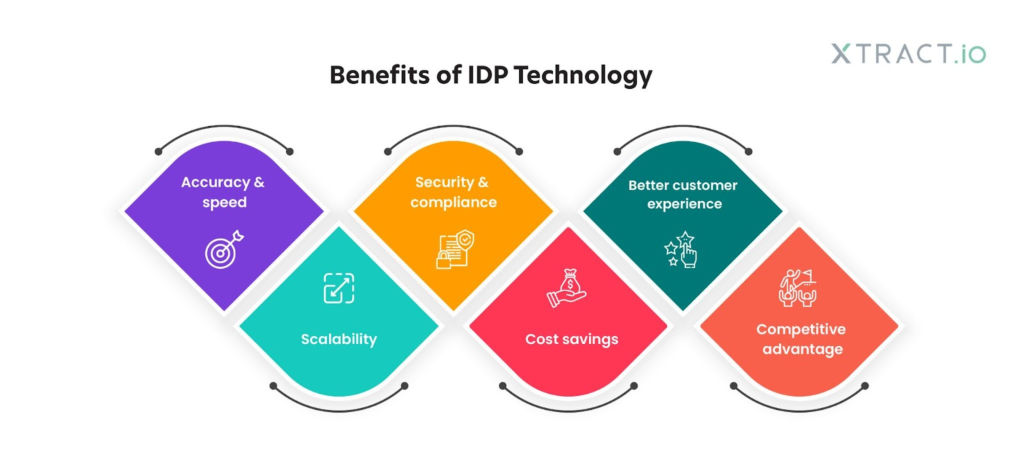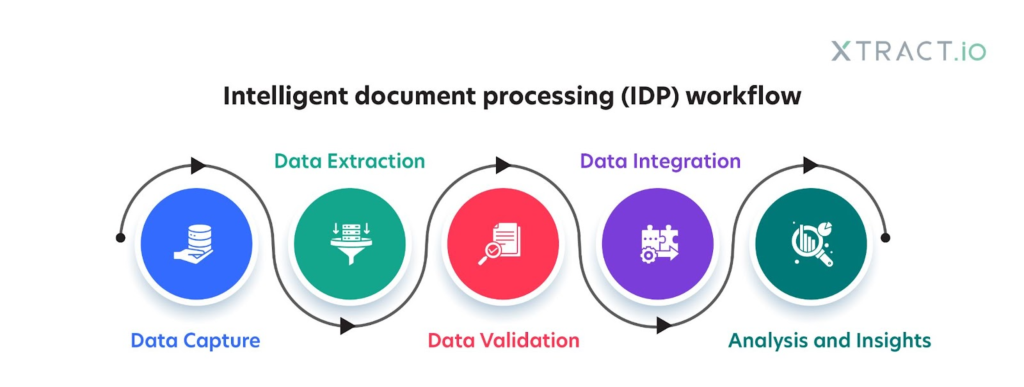IDP – Intelligent Document Processing is a technology that reimagines how businesses process and automate data. While over 80% of business documents are unstructured, organizations turn to automate the process of capturing, extracting, and processing the information.
Intelligent document processing is an ideal technology to address the challenges of reading complex documents. It is widely popular for its astounding benefits to businesses, such as delivering data accuracy, eliminating manual intervention, improving efficiency, meeting legal & compliance requirements, and much more.
Read ahead to discover what Intelligent Document Processing (IDP) is, how it works, its benefits, and some significant use cases.
What is Intelligent Document Processing?
Today’s businesses can automate extraction for dense and unstructured data thanks to intelligent document processing (IDP). It is a next-generation technology that helps transform raw data into usable formats, delivering information for business operations.
The IDP solutions can be easily integrated with document/data management systems, allowing businesses to organize documents more quickly. Adopting Intelligent Document processing can provide better data quality, making it easier to uncover insights that will guide business decisions. While employees can save hours of tedious work in data entry and focus more on high-value tasks.
Intelligent Document Processing utilizes technologies such as Artificial Intelligence, Machine Learning, Natural Language Processing (NLP), Intelligent Character Recognition (ICR), and Optical Character Recognition (OCR) to cover the entire document process (Classification, Categorization, Extraction, and Validation).
IDP technology is gaining momentum in data extraction with rapid advancements in artificial intelligence. The technology is also referred to as Cognitive Data Processing, Intelligent Data Capture, Intelligent Data Extraction, and Machine Learning OCR. Although It is more often presumed to be an extension of OCR. The IDP solution is instead a powerful replacement for OCR solutions.
The key differences between OCR and IDP
Optical Character Recognition (OCR) and Intelligent Document Processing (IDP) technologies are known for extracting and processing unstructured data. They are not the same, despite some similarities.
OCR solutions are widely used to extract text from scanned and digital documents. It is suitable for analyzing images, individual characters, or specific words and converting them into machine-readable text. In short, OCR can convert physical documents into digital text that can be searched, edited, and processed within a system.
On the other hand, IDP technology is more advanced than OCR. IDP solutions can help identify and extract information such as addresses, dates, names, and other data points from documents and PDFs. It analyzes the content of the documents to classify them. Later categorizes the documents into appropriate formats to perform other automated tasks.
Traditional OCR focuses solely on converting images into text that is difficult to read or where the text is damaged. However, IDP offers the highest efficiency in reading documents and PDFs to deliver accurate data.
Business benefits of Intelligent Document Processing
IDP can automate the manual data entry process allowing medium to large enterprises to capture and extract documents with greater complexities. Here are some significant benefits it can offer businesses.

1. Improved accuracy & speed: IDP can help eliminate errors during manual document processing. The machine learning algorithms used in IDP can learn from previous document processing tasks, which can help improve accuracy over time. Automation speeds up processes, saves time, and reduces errors in the workflow.
2. Scalability: IDP technology is highly scalable and suitable for businesses of all sizes. Whether an organization needs to process a few hundred documents a month or thousands of documents a day, IDP solutions can be customized to meet their needs.
3. Improved security & compliance: IDP can help organizations comply with regulatory requirements by accurately capturing and storing all relevant data.
4. Cost savings: Adopting IDP can help reduce the costs associated with manual document processing, such as labor, printing, and storage costs. By automating the document processing workflow, organizations can also reduce the risk of errors that can lead to expensive rework.
5. Improved customer experience: IDP can help deliver an improved customer experience by speeding up response times and minimizing the time it takes to process documents.
6. Competitive advantage: The technology provides a competitive capability by allowing them to process documents more quickly than their competitors. This can help organizations win new business and retain existing customers.
More importantly, IDP technology can understand the data it’s scanning. This means businesses can continuously gain insights, enable optimal performance, and reduce human intervention in document processing.
IDP workflow: how does it work?
There are a few fundamental steps to Intelligent document processing workflow.

Data Capture: As a first step, IDP solutions begin document processing by capturing unstructured data from various sources such as paper documents, PDFs, images, emails, etc.
Data Extraction: After capturing the data, IDP solutions apply natural language processing (NLP) and optical character recognition (OCR) techniques to recognize and extract relevant information from the document.
Data Validation: The extracted data is then validated by comparing it against predefined rules or through human review to ensure accuracy and completeness.
Data Integration: After the data is validated, it is processed and transformed into structured data that can be easily integrated with other systems, such as a database, business intelligence tools, or a content management system.
Analysis and Insights: Once the structured data is available, advanced analytics tools such as data mining and machine learning algorithms can be applied to gain insights and make informed business decisions based on the data.
Top use cases for Intelligent Document Processing
IDP technology can perform document processing across multiple industry use cases. IDP can be customized to scale when automating document processing.
Logistics
Intelligent document processing is increasingly used in logistics businesses to effectively manage supply chains, transportation, shipping, and doorstep delivery. As there are a lot of third parties involved throughout the processes, the information has to be validated, cross-checked, and verified for the requirements to get into manual processing.
IDP solves this problem where it can read unstructured data from various sources, thus eliminating the need for human intervention and saving time throughout the process. Businesses expanding their user base or scaling their document processing can leverage the IDP automation solution to keep the workflows in check.
Insurance
Insurance companies use IDP technology to streamline processes to manage vast customer data insurance claims, expedite claimant-signed forms, and detect fraud. With an increasing number of claims, there is a need to match the requirement of supporting documents, invoices, photos, and receipts to fulfill the claims.
Based on customer data, IDP helps determine the risk appetites and offers the best policies with attractive benefits. Intelligent document processing replaces intensive manual work and process errors with an automated workflow.
Banking and financial services
In banking and financial services, lenders should navigate through many KYC documents to verify the clearing payments, determine the credit score, mitigate risks, and react quickly to them. Banks and lenders use IDP solutions to organize data stuck within inaccessible documents and make them easily accessible across multiple departments.
IDP technology fast-tracks the customer journey and ensures faster turnaround time for financial services. It also helps eliminate the need to manually analyze loan applications, personal identification documents, and other forms to deliver better services without compromising quality.
Commercial real estate
Intelligent document processing enables commercial real estate by expediting rental and lease agreements. It also includes memorandums, operating statements, analyzing market prices, and determining lucrative investments. Property owners and commercial real estate firms use IDP solutions to pull data from multiple sources. This helps them decide on prime locations and purchase new properties that will provide significant returns on investment.
The IDP solution derives insights into real-time market comparisons and automates cash flow analysis. So that businesses can make faster decisions and quickly grab profitable investments.
Conclusion
The volume of data across industries will only continue to increase. It is impacting businesses with more challenges in processing semi-structured and unstructured documents. However, the benefits of Intelligence document processing (IDP) are evident. Many companies are cautious about adopting this latest technology and doubtful of its outcomes.
Moving forward with advanced automation technologies is crucial to overcoming document processing challenges. Any business can achieve greater efficiency and cut-down costs with automation. Combining low-code and no-code solutions with a minimal learning curve makes applying IDP technology across business functions easier. Intelligent data processing elevates organizations to achieve ROI faster and improve the bottom line.







